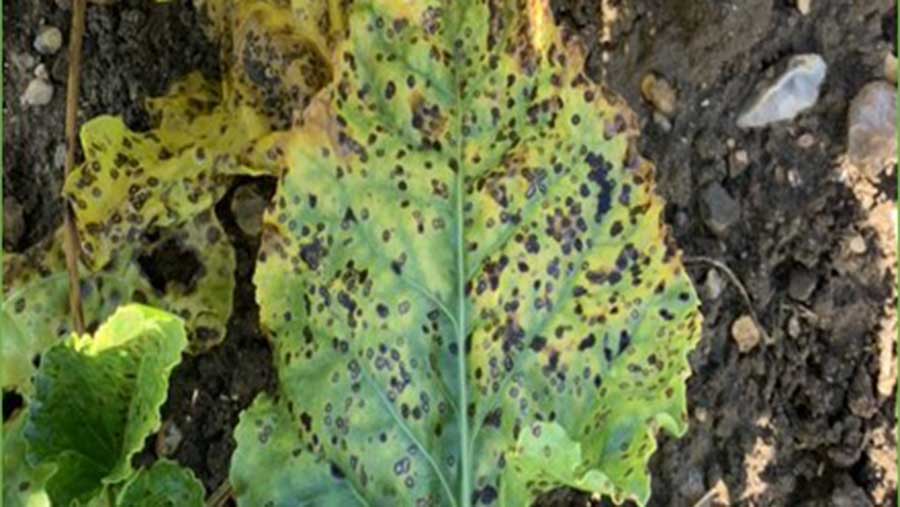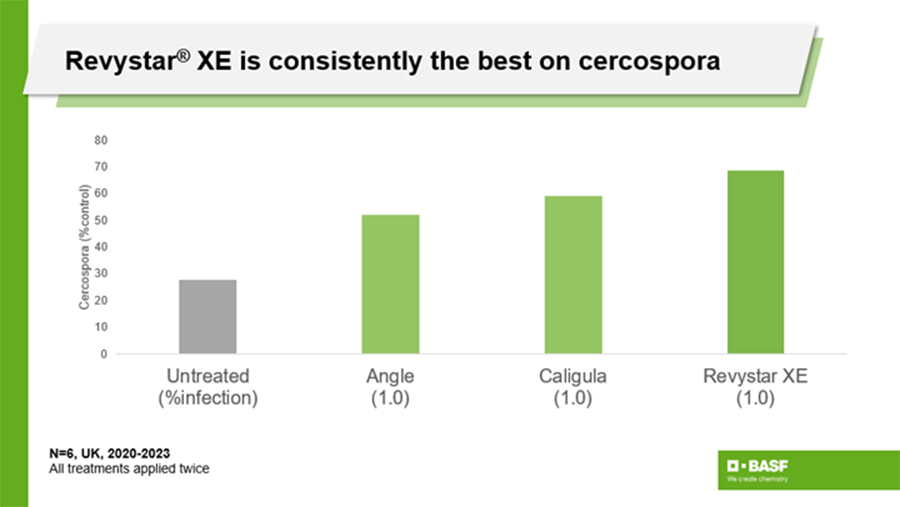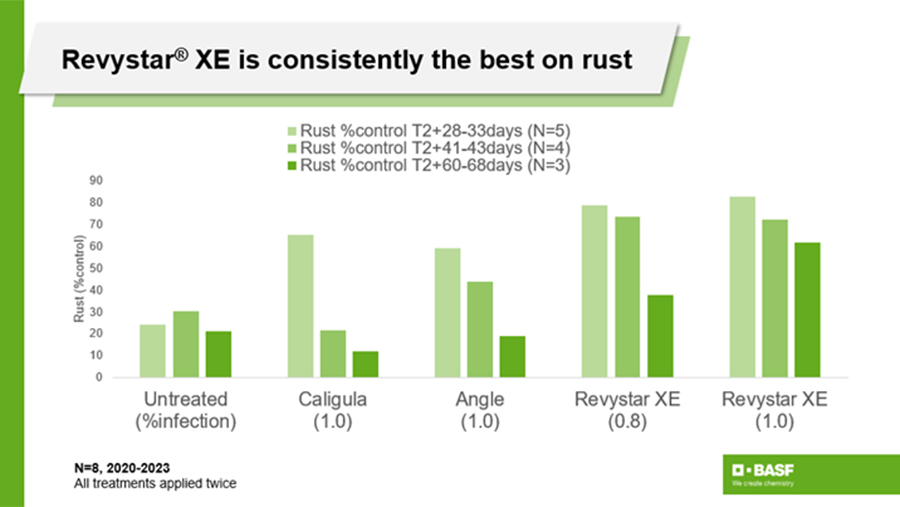Advertiser content
Tackling the triple threat of disease facing sugar beet
Like many sugar beet growers, Mike Wilton had barely finished lifting last year’s crop when this year’s went into the ground.
It’s an obvious sign of the impact of changing weather patterns.
More subtle, perhaps, are the effects of the milder winter on the crop’s diseases – from enabling traditional pathogens like rust and powdery mildew to survive the season unhindered by prolonged cold temperatures, to allowing the ‘new kid on the block’, Cercospora, to take hold.

Cercospora © BASF
“I don’t believe I have ever lifted sugar beet in March before, let alone finished at the end of the month,” says Mike.
As well as 600ha of contract farms, Mike manages the Stody Estate’s acreage in North Norfolk.
“For various reasons, that crop sat in clamps until 8th/9th April.
“And, with the current regime of not overtopping beet, there is undoubtedly an element of the green on those crops creating a fantastic microclimate for disease.”
Mike’s clamps are centrally located within blocks of his fields. While this has many logistical advantages, it’s not ideal for controlling inoculum.
“It’s a source of infection,” Mike surmises.

Mike Wilton © BASF
Iain Ford, BASF business development manager, agrees that diseases increasingly have green bridges helping them to survive the winter months.
“While practices such as no-till and min-till are valuable for their role in soil health, they inevitably leave surface trash on which diseases like Cercospora can survive.”
Cercospora
Cercospora is a relatively new disease for the UK. It’s been traditionally found in mainland Europe as it thrives in hot and humid conditions.
“As well as the UK experiencing warmer conditions in the summer, experts at BBRO are saying that there are indications that the pathogen is adapting to the cooler UK conditions,” explains Iain.
“Where European growers have been reliant on strobilurins, it’s developed some levels of resistance. It’s certainly something we need to be mindful of here in the UK.”
“Given we know that repeated applications of the same active ingredient are known to drive selection of resistant isolates, it’s frustrating that product choice in sugar beet is so limited” says Mike.
Iain agrees, adding: “It’s one of the reasons the launch of Revystar XE into beet last year was so important.
“Not only is it a new product, but it contains two different modes of action, with Revysol and Xemium both bringing excellent disease control in their own right.
“All the available fungicides for beet are protectant, so it’s important to use the strongest at the start of the season, as you can never recover lost yield and it’s very hard to chase disease once it becomes established.”
Revystar® XE has proven to be highly effective against Cercospora. Between 2020 and 2023, BASF has conducted extensive trials of the product.
“Those trials have consistently shown that Revystar XE outperforms other products in isolation and as part of a programme,” says Iain.
In four of those trials, each product was applied twice in order to isolate their effects while mirroring a ‘typical season’.
“For experimental purposes that included two applications of Caligula (SDHI and triazole); however, with growers being restricted to applications on or after 1st September, in practice, two sprays of Caligula is unlikely.
“These trials are a useful indicator of individual product performance, and demonstrates how Revystar XE outperforms other products, offering on average nearly 70% control while the competitors offer only 50-60% control.”

© BASF
Powdery mildew and rust
Alongside Cercospora, growers are facing increased threat this year from the traditional diseases, powdery mildew and rust.
“Powdery mildew pressure is known to be closely linked to the number of ground frosts in February and March and large parts of the country had very few, if any.
“Come July, the potential is for very high pressure.” explains Iain.
“We also need to watch out for rust, as we saw the pathogen continue to develop in crops throughout the autumn last year.
“The mild winter will have allowed this to survive and carry over into this year’s crop.”
Fortunately, Revystar® XE also offers good control of both these diseases, and growers also have flexibility on rate, depending on the target pathogen.
“Though trials have shown that there is a dose rate response with Revystar XE, we try to introduce products in a practical and cost-effective way,” says Iain.
“We know 0.8 L/ha will give really good control of powdery mildew and rust – it’s an option that can help reduce spending where these diseases are the only targets.
“Where Revystar XE is being aimed at Cercospora, the higher rate of 1.0l/ha is needed.”
If longevity of rust control is a key consideration, Revystar® XE at the higher rate will be the most effective option according to Iain.
“Across eight trials between 2020 and 2023, different assessment timings showed how 1.0l/ha Revystar XE provided excellent longevity of control compared to those treated with any other product,” he says.
“The trials reinforce what we’ve consistently seen elsewhere – that Revystar XE is consistently the most effective product for rust control.”

© BASF
Mike’s fungicide programmes centre on Revystar® XE
Mike varies his fungicide programme depending on when the crop is due to be lifted.
“The beet that was intended to be harvested early received only one spray last year.
“Most of the acreage had two sprays, and a small acreage of lighter land – which was due to be lifted at the end of the campaign – received three.”
While all crops received Revystar® XE, for resistance management, the two and three spray programmes were also treated with Priori Gold (azoxystrobin and difenoconazole).
“Unfortunately, due to the weather we had to lift some of the lighter land earlier than planned and we didn’t see the full benefit of that three-spray programme.
“What we did see with that fungicide programme was great green leaf retention – it was the best I’ve seen for at least 10 years.”
Mike’s confidence in using the new product stems from previous experience, having used Revystar® XE for a number of years in other crops.
“We know it mixes well, is easy to use and, if we need to, can add micronutrients for application at the same time,” he says.
Timing of applications
Treatments were applied at one month intervals, with the last being applied around 15th September.
“This late in the season our objective is to get as much longevity from the products, with the assumption that the weather will slowly turn colder, extending their life until the disease is no longer active,” he says.
While this is currently a robust and practical approach, and one that Iain would recommend, he says it may need to change in the future.
“Fungicides have a certain longevity, usually around four weeks after application but it can be up to six, depending on disease pressure and if conditions allow.
“With the products being protectant in their activity, Mike’s approach will keep on top of the inoculum and helps to prolong the fungicides’ activity.
“In theory, that ought to keep crops clean until the winter sets in.
“However, as we saw this winter, the weather is changing and milder winters are allowing the pathogens to stay active for longer.
“We may need to review this best practice approach in the coming years.”
Mike already pays close attention to nutrition and has started thinking about drilling and lifting crops according to varietal resistance.
“It’s a good idea,” says Iain. “An integrated approach combining varietal tolerance with fungicide use is going to be key to future disease control.”
Provided by
BASF offers renowned and innovative fungicides, herbicides, insecticides and growth regulators for agriculture. Our products and services help farmers increase their yields and optimize the quality of their products.
